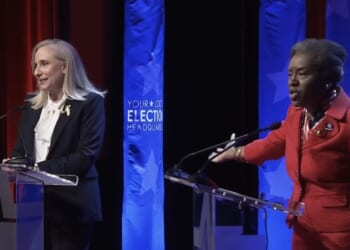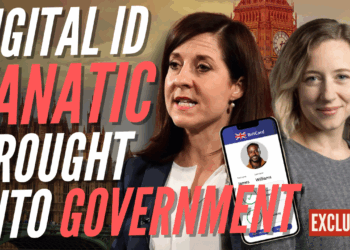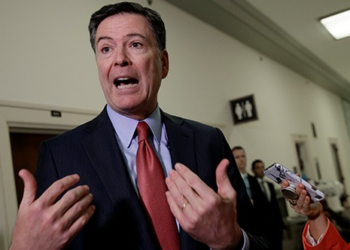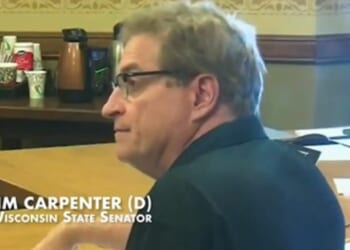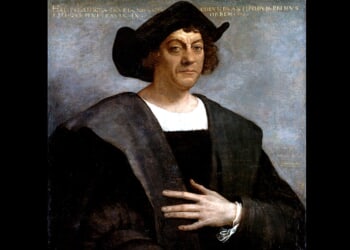Lord Ashcroft KCMG PC is an international businessman, philanthropist, author and pollster. For more information on his work, visit lordashcroft.com
My latest poll looks at Labour’s plans for digital ID; the balance between economic ties and national security in relations with China; Tory plans on the ECHR, Stamp Duty and net zero; prospects for the economy and the Budget; whether the party leaders will still be in post this time next year; and who people expect to be prime minister after the next election.
What have people noticed? And who noticed what?
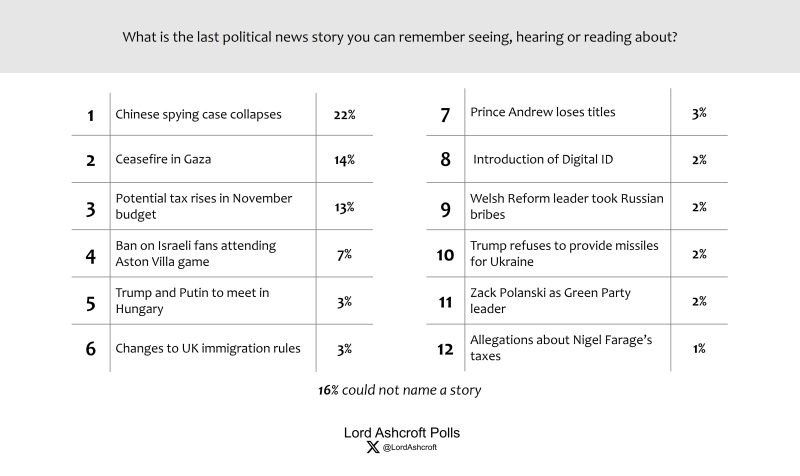
The collapse of the China spying case was the most-recalled recent political news story, ahead of the Gaza ceasefire, speculation about Budget tax rises, and the decision to ban visiting Israeli football fans from attending their game with Aston Villa.
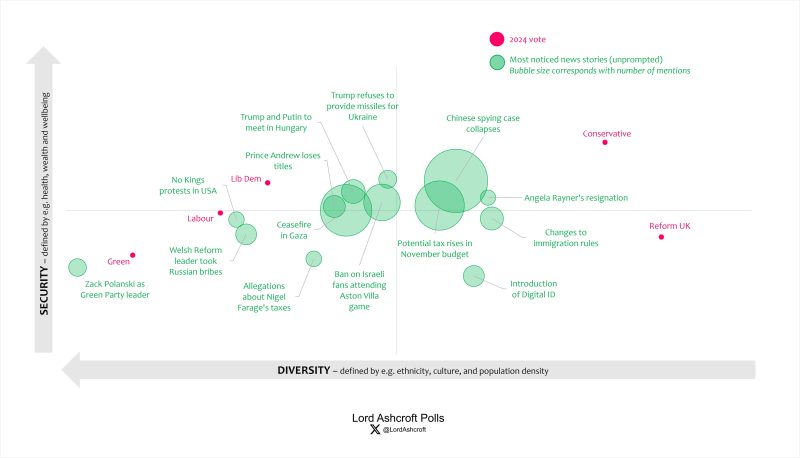
Our political map shows what kind of voters were most likely to recall which news. Stories about Gaza, Israeli football fans, Budget tax rises and the China spying case all appear close to the centre, meaning they were not confined to any particular corner of the electorate. Digital ID and immigration were most likely to be mentioned in the Reform-leaning bottom right quadrant, while news about Zack Polanski, Nigel Farage’s taxes and the No Kings protest in the US were most likely to have been clocked on the left-hand side of the map.
Digital ID
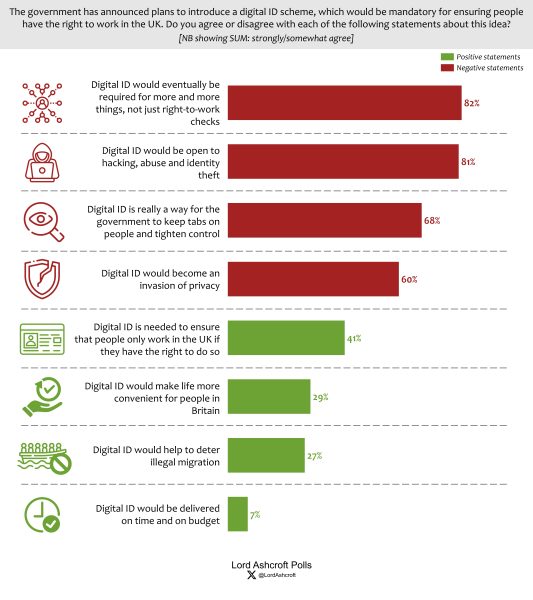
We asked how strongly people agreed with various statements about the government’s plans to introduce a digital ID scheme. Only a minority believed digital ID was needed to ensure that people only work in the UK if they have the right to do so, that it would make life more convenient, or that it would deter illegal migration, let alone that it would be delivered on time and on budget.
However, large majorities believed digital ID would become an invasion of privacy, that its real purpose was to allow the government to keep tabs on people and tighten control, that it would be open to hacking, abuse and identity theft, and that it would eventually be required for more and more things, not just right-to-work checks. Clear majorities of 2024 Labour voters agreed with the last three of these statements.
The economy and the Budget
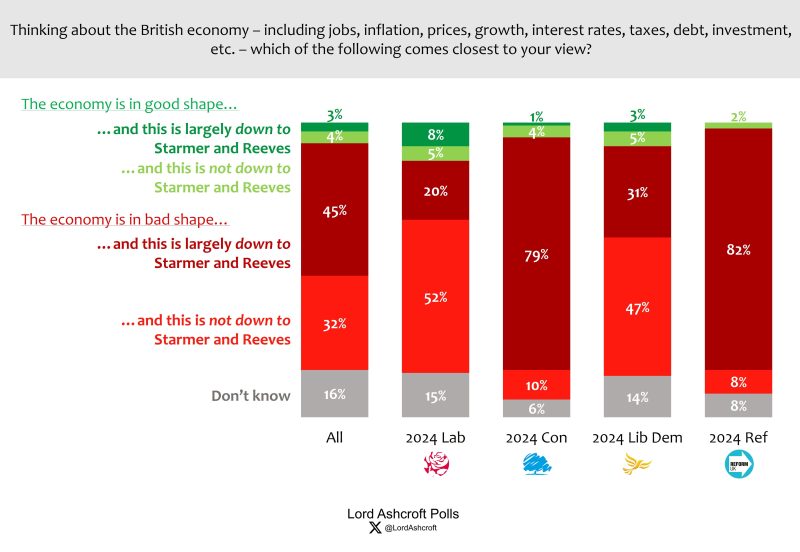
More than three quarters said they thought the economy was in bad shape, including 45 per cent who thought this was largely down to Keir Starmer and Rachel Reeves. More than 7 in 10 2024 Labour voters agreed the economy was in bad shape – and while they were less likely to blame the PM and the Chancellor, one in five of them did so. Only 7 per cent thought the economy was in good shape, including just 3 in a hundred who thought this was down to Starmer and Reeves.
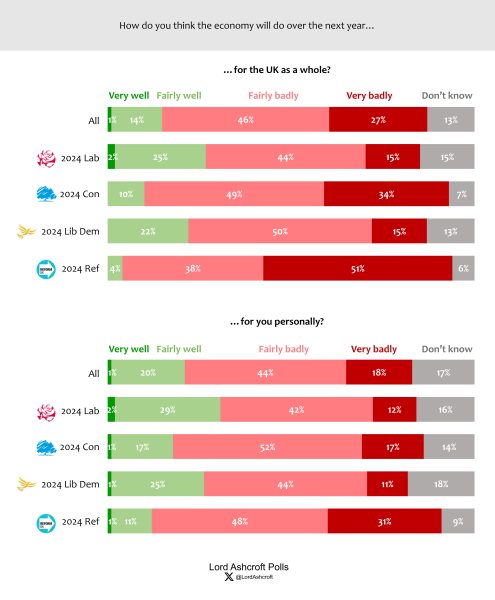
Voters as a whole thought the economy would do badly over the next year for the country as a whole by a 58-point margin. Those who voted Labour in 2024 thought this by a 32-point margin. People also thought the economy would do badly for them personally, though by a slightly lower 41-point margin. More than half of 2024 Labour voters expected things to go badly for them.
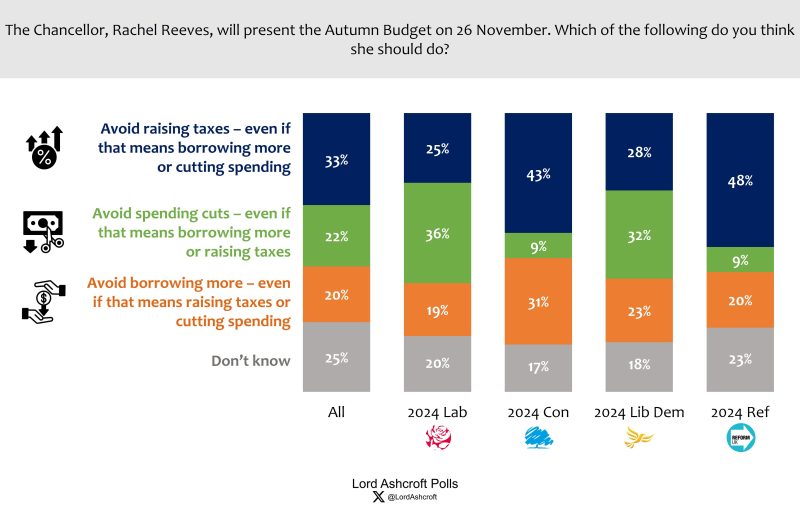
Asked whether the Chancellor should avoid raising taxes, cutting spending or borrowing more, one third said avoiding tax rises was the most important, even if this meant borrowing more or cutting spending. Just over 1 in 5 said she should avoid spending cuts, even if this meant borrowing more or raising taxes. The 11-point preference for avoiding tax rises over avoiding spending cuts is up from 6 points when we asked the same question ahead of the Spending Review in June.
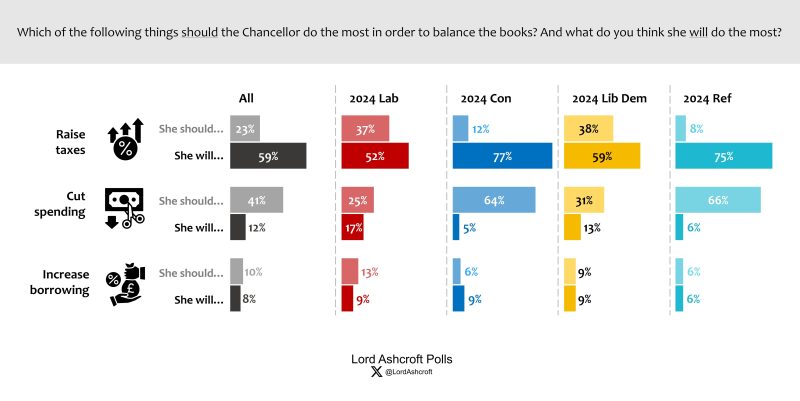
Fewer than a quarter of voters thought Rachel Reeves should raise taxes to balance the books, but more than half thought she would do so. Just over 4 in 10 thought she should cut spending, but only 12 per cent thought she would. More than half of 2024 Labour voters thought Reeves would raise taxes, compared to 37 per cent who thought she should do so.
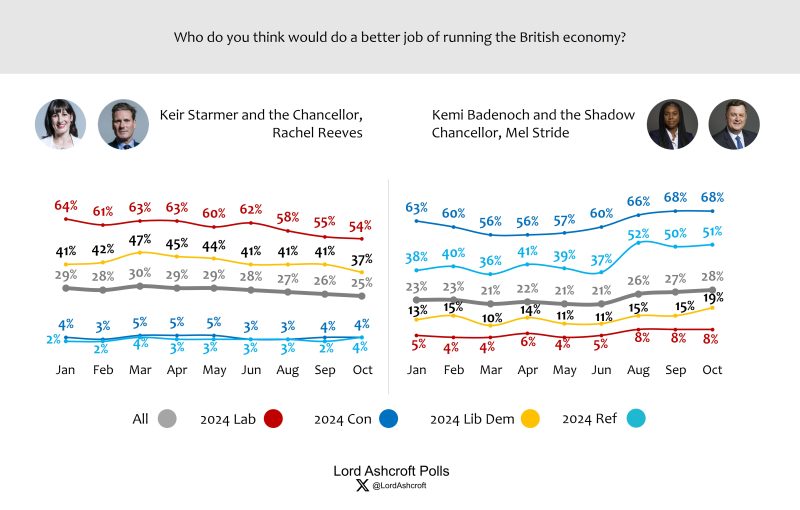
Asked who would do the better job running the economy, voters chose Kemi Badenoch and Mel Stride over Keir Starmer and Rachel Reeves by a 3-point margin with nearly half saying “don’t know”. Just over half of 2024 Labour voters named the Labour team; more than two thirds of 2024 Conservatives chose the Tory team.
Stamp Duty
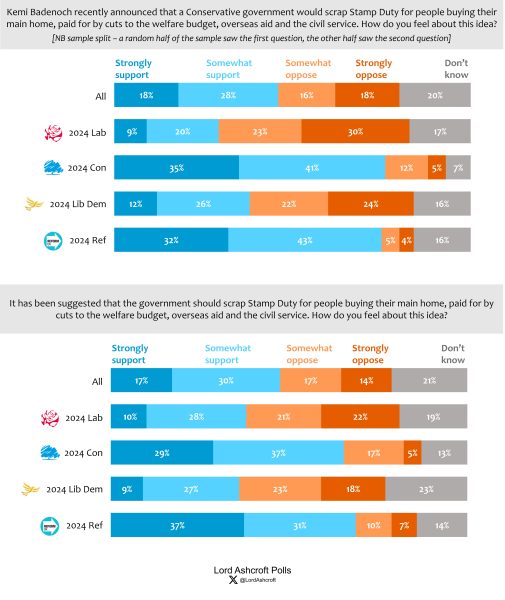
Overall, just under half of all voters said they supported the idea of scrapping Stamp Duty whether or not they knew it had been proposed by the Conservatives. However, 2024 Conservative voters were considerably more likely to back the plan when the party was named than when it wasn’t, while Labour voters were more likely to back it when the Tories were not mentioned than when they were not. Nearly three quarters of those who switched away from the Conservatives in 2024 said they supported the idea when told it had come from the Tories.
The ECHR and Indefinite Leave to Remain
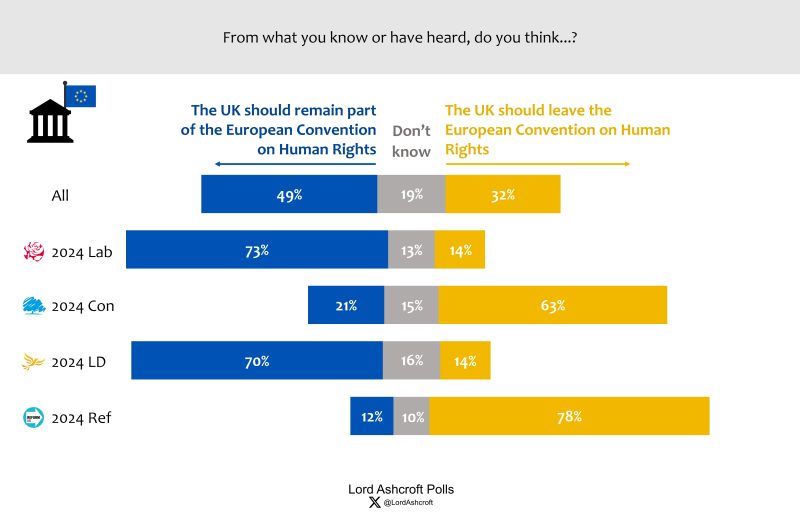
Voters overall thought the UK should remain part of the ECHR by a 17-point margin, with 2024 Labour voters wanting to do so by 73 to 14 per cent. However, 2024 Conservatives wanted to leave by a 42-point margin and Reform voters by 66 points.
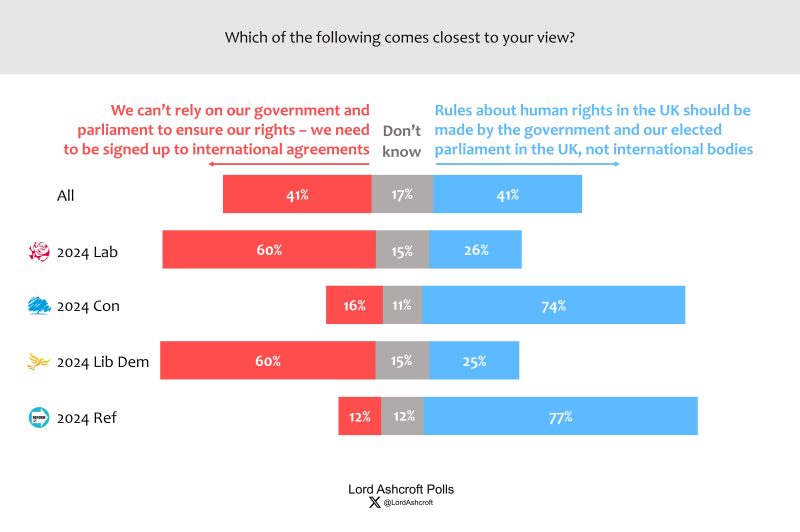
Voters overall were exactly divided as to whether rule about human rights in the UK should be made by the government and parliament, or whether we need to be signed up to international agreements to ensure our rights. Around three quarters of 2024 Conservative and Reform voters wanted rules to be made by the government and parliament; 6 in 10 Labour and Lib Dem voters, and around three quarters of Green and SNP voters wanted to be part of international agreements.
Net Zero
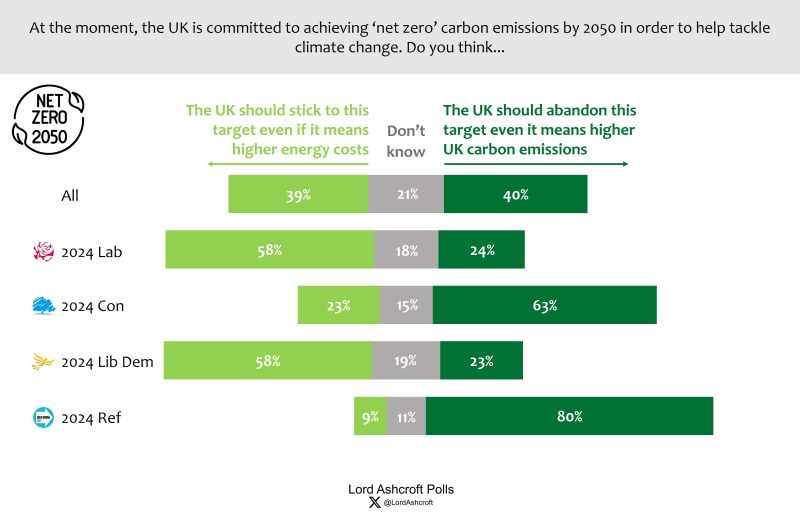
Voters were quite evenly divided between wanting to stick to the net zero target even if this meant higher energy costs and abandoning net zero even if it meant higher UK carbon emissions. 2024 Labour and Lib Dem voters wanted to keep the target (by 34 and 35 points respectively). Conservatives wanted to scrap net zero by a 40-point margin, and Reform voters by a 71-point margin.
China and the UK
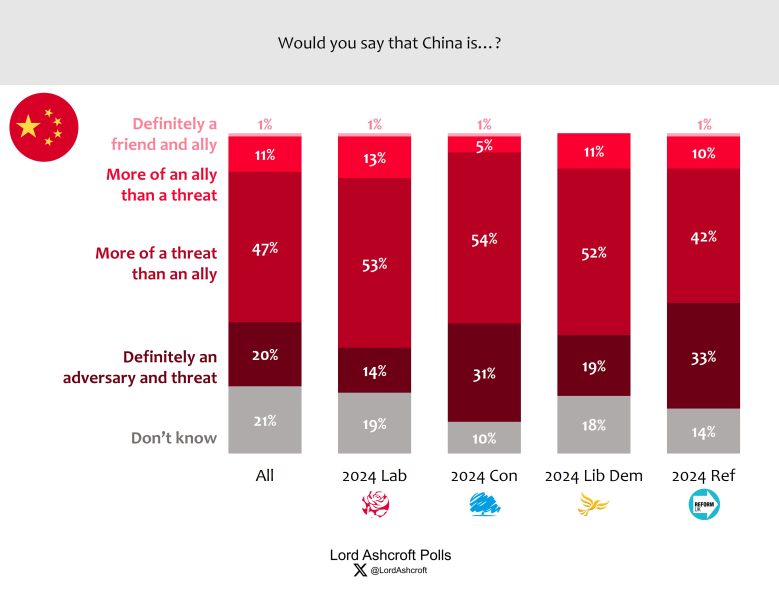 More than two thirds of voters said they thought China was more of a threat than an ally to the UK, including 1 in 5 who thought the country was definitely an adversary and a threat. Large majorities of 2024 Tories and Reform UK voters saw China as more of a threat than an ally, as did Labour voters and those who voted Lib Dem. One in five Green voters saw China as more of an ally than a threat, making them the most likely to do so.
More than two thirds of voters said they thought China was more of a threat than an ally to the UK, including 1 in 5 who thought the country was definitely an adversary and a threat. Large majorities of 2024 Tories and Reform UK voters saw China as more of a threat than an ally, as did Labour voters and those who voted Lib Dem. One in five Green voters saw China as more of an ally than a threat, making them the most likely to do so.
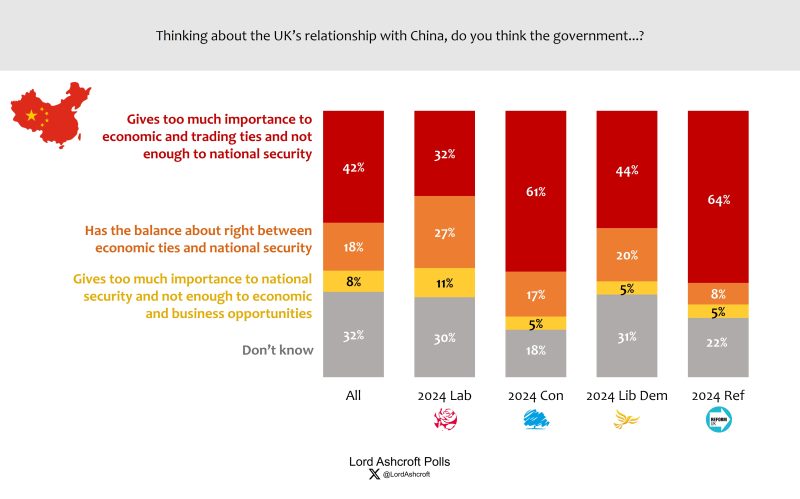
Voters were more than twice as likely to think the government gives too much importance to economic ties with China and not enough to national security than the reverse. 2024 Labour voters also tended to think this was the case, but by a smaller margin.
Party leaders
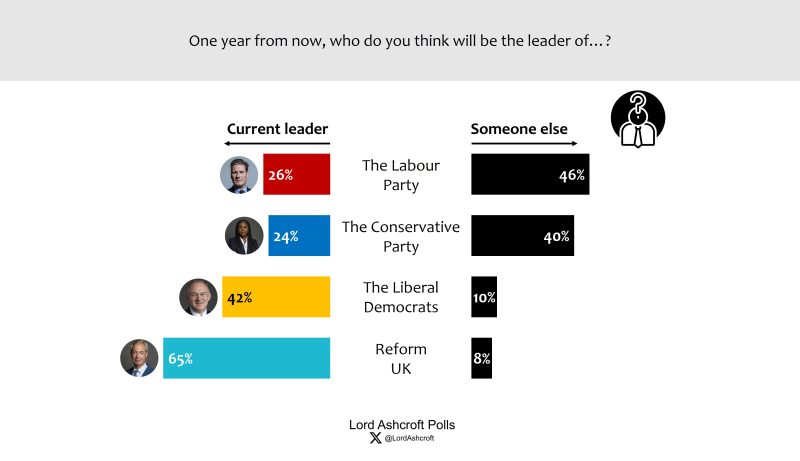
Only just over a quarter of all voters said they thought Keir Starmer would still be leader of the Labour Party in one year’s time, down from 35 per cent in August. The other leaders were all thought to be in a stronger position than two months ago: 24 per cent thought Kemi Badenoch would still be in her job (up 4 points), 42 per cent thought Ed Davey would be in his (up 5 points) and 65 per cent thought Farage would be in his (up 6 points).
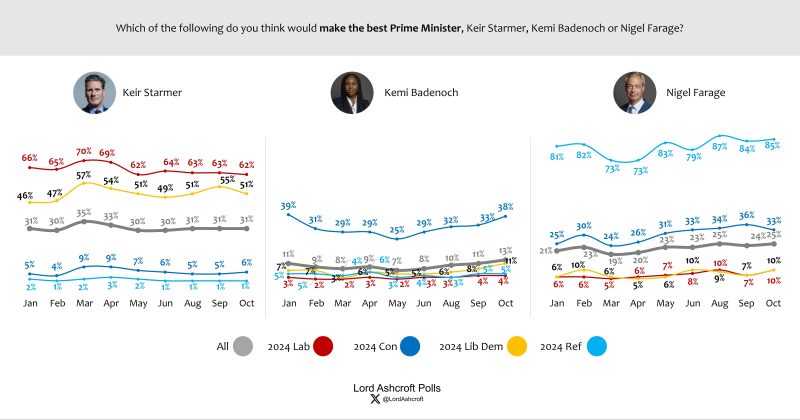
Asked who would make the best prime minister between the three main party leaders, voters chose Starmer over Farage by a 6-point margin, with Badenoch in third place on 13 per cent. The rise in the proportion of Conservative voters naming Badenoch since the middle of the year is the biggest change since we first asked the question in January. Given a choice between Starmer and Badenoch, voters chose Starmer by a 4-point margin. Given a choice between Starmer and Farage, voters as a whole chose Starmer by 40 per cent to 31 per cent.
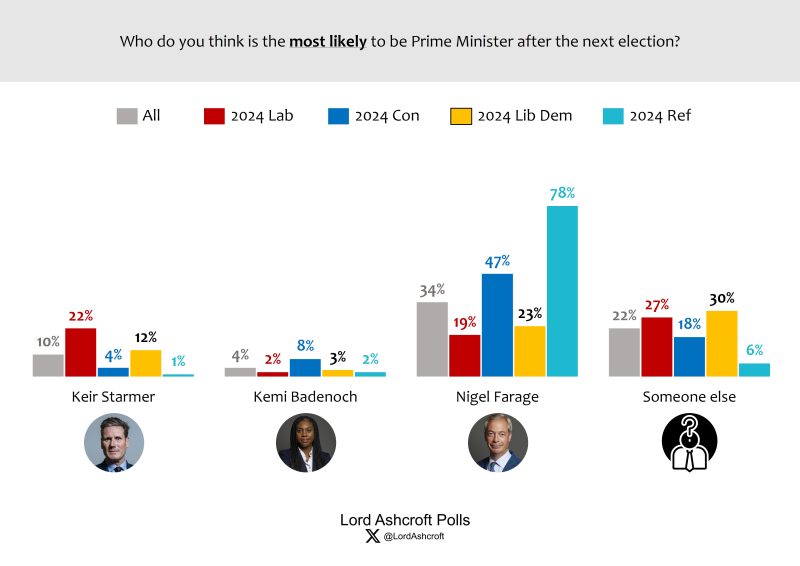
Nigel Farage was thought the most likely person to be PM after the next election, with just over one third naming him as the most likely candidate. Only 1 in 10 thought Starmer would still be in the job and 4 per cent named Badenoch. More than 1 in 5 thought someone else would be PM. 84 per cent of those currently intending to vote Reform thought Farage would be PM, compared to 38 per cent of Labour voters who thought Starmer would be PM and 14 per cent of current Conservative voters who thought Badenoch would have the job.
What have Labour done so far?
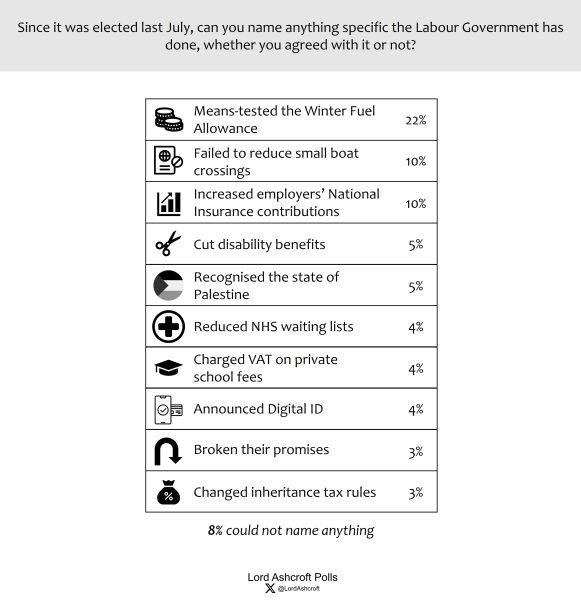
Cuts to the winter fuel allowance continue to top the table when we ask what the Labour government has done since it came to power in July 2024. Failing to stop small boat crossings and increasing employers’ National Insurance come joint second, followed by cutting (or attempting to cut) disability benefits – which tied with recognising a Palestinian state with 5 per cent of respondents mentioning it.
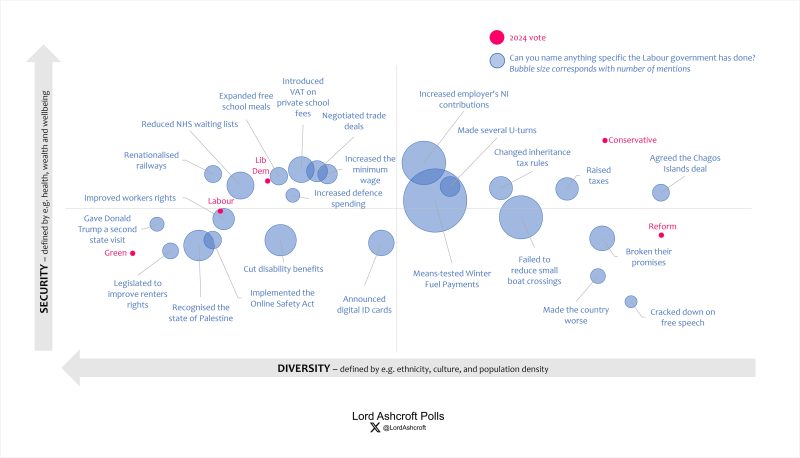
Our political map shows that winter fuel and employers’ NI were fairly universally recalled. Small boats, tax increases and the Chagos Islands deal were most likely to be mentioned in the Conservative- and Reform-leaning top and bottom right, while benefit cuts, recognition of a Palestinian state, renters’ and workers’ rights, free school meals and President Trump’s second state visit were most likely to be recalled in Labour, Lib Dem and Green territory on the left-hand side of the map.
The next election
We ask respondents how likely they are to vote for each party at the next election on a 100-point scale. Looking at those more likely than not to vote for a particular party (those whose highest likelihood of voting for one party was at least 50/100), this implies a current vote share of 29 per cent for Reform UK with Labour and the Conservatives tied on 19 per cent, the Greens on 17 per cent and the Lib Dems on 11 per cent. Those who voted Labour in 2024 put their chances of doing so again at the next election at an average of 44/100. Those who voted Conservative were more likely to repeat their 2024 vote (57/100). Those who voted Reform UK put their chances of doing so again at 73/100.
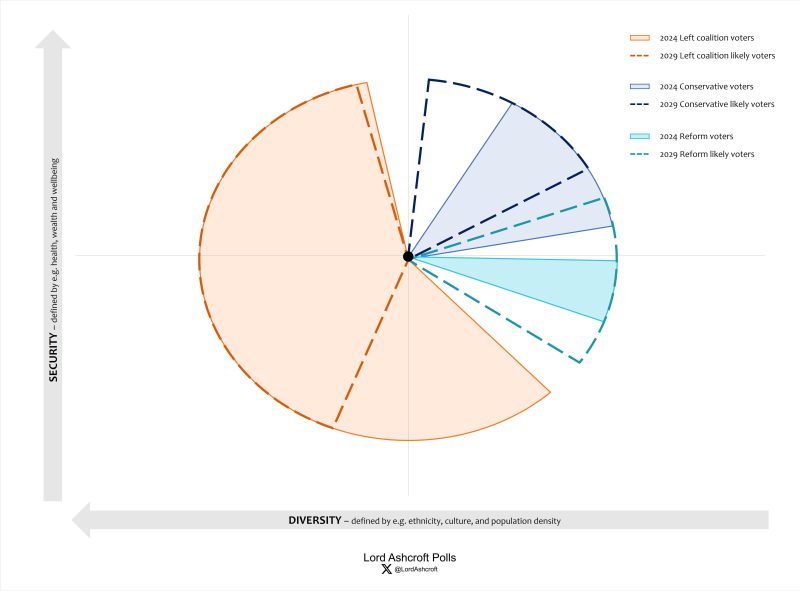 This map shows the changing size and shape of the left and right voting coalitions since the 2024 election. Each “slice” shows the part of the electorate in which one party or coalition has a plurality among voters – that is, where people are more likely to vote for that party than anything else. (The white spaces are effectively no-man’s land, where no one party or coalition has a plurality).
This map shows the changing size and shape of the left and right voting coalitions since the 2024 election. Each “slice” shows the part of the electorate in which one party or coalition has a plurality among voters – that is, where people are more likely to vote for that party than anything else. (The white spaces are effectively no-man’s land, where no one party or coalition has a plurality).
We can see that in 2024 the left coalition, comprising Labour, the Lib Dems, the SNP and Plaid Cymru, covered most of the top left quadrant, the whole of the bottom left and nearly half of the bottom right. It has now shrunk significantly no longer commands a plurality in any part of the less prosperous, less diverse bottom right. Meanwhile, the slice dominated by Reform UK has expanded into the more secure top right quadrant, with the Conservatives pushed further into that quadrant and further from the Brexit-backing bottom right which formed a crucial part of their 2019 majority.
The political map
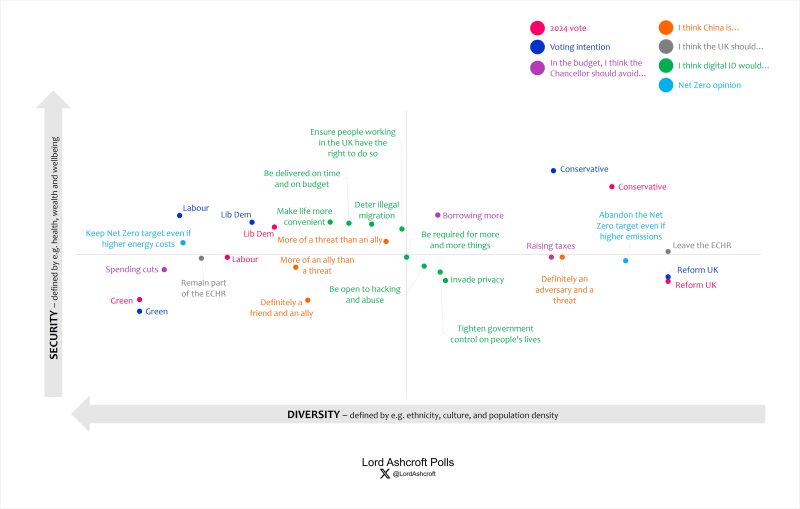
As above, our political map shows how different issues, attributes, personalities and opinions interact with one another. Each point shows where we are most likely to find people with that characteristic or opinion; the closer the plot points are to each other the more closely related they are. Here we can see that those wanting to avoid tax rises and borrowing increases in the November Budget are most likely to be found on the right-hand side of the map, while those who prioritise avoiding spending cuts are most likely to be found in Labour and Green-leaning territory. We can also see that the minorities who agreed with positive statements about digital ID were all most likely to be found in the left-hand side of the map, while those believing it would eventually be required for more and more things besides right-to-work checks appeared exactly in the centre, meaning it gained wide agreement throughout the electorate.
Full data tables are at LordAshcroftPolls.com

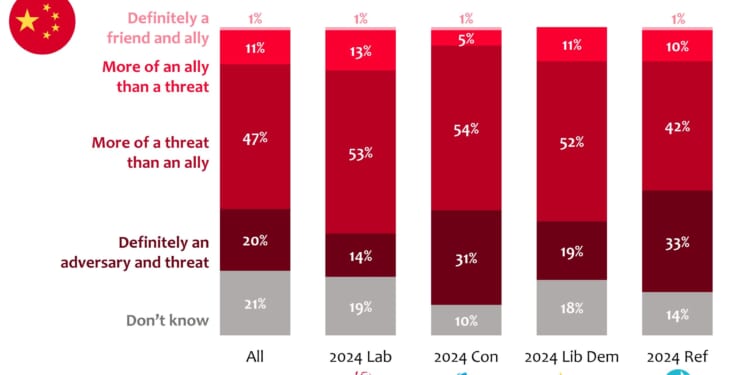
![Scott Bessent Explains The Big Picture Everyone is Missing During the Shutdown [WATCH]](https://www.right2024.com/wp-content/uploads/2025/11/Scott-Bessent-Explains-The-Big-Picture-Everyone-is-Missing-During-350x250.jpg)

